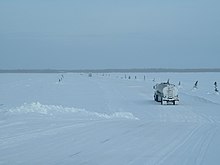Winter road



Winter roads are roads that are built over land on compacted snow, frozen tundra and bare ground, or on floating ice covers.[1][2][3] Segments of a winter road that cross an expanse of floating ice are also referred to as an ice road or an ice bridge.[1][2][4][5] Conversely, a winter road may be built mostly on floating ice, with occasional land crossing called 'portages' - the Tibbitt to Contwoyto Winter Road is an example.
Winter roads facilitate transportation during the winter to, from and within isolated areas in the North where there are no permanent (or 'all-weather') roads. They enable supplies (e.g. food, fuel, construction material) to be brought into communities in these areas.[6] The only other alternative, providing there is a small airstrip nearby, would be to rely on air transportation. However, this can be prohibitively costly, especially for bulk material.[6][7] In some areas, climate change is observed to affect winter roads, notably by contributing to a significant reduction in their operational lifespan.[7][8]
See also
References
- ^ a b IHSA, 2014. Best practices for building and working safely on ice covers in Ontario, Mississauga, Ontario, 43 p.
- ^ a b NorthWest Territories Transportation, 2015. Guidelines for safe ice construction, Yellowknife, NWT, Canada, 44 p.
- ^ Spencer, P.A., Strandberg, A.G. and Maddock, W.A., 2008. Ice and toundra road design for module transport, Proceedings of the 8th International Conference on Ships and Marine Structures in Cold Regions (ICETECH), Banff.
- ^ Michel, B., Drouin, M., Lefebvre, L.M., Rosenberg, P. and Murray, R., 1974. Ice bridges in the James Project. Canadian Geotechnical Journal, 11: 599-619.
- ^ Barrette, P.D., 2015. A review of guidelines on ice roads in Canada: Determination of bearing capacity, Transportation Association of Canada (TAC), Charlottetown, PEI.
- ^ a b Kuryk, D. and Domaratzki, M., 1999. Construction and maintenance of winter roads in Manitoba, Proceedings of the 10th Workshop of the Committee on River Ice Processes and the Environment (CRIPE), Winnipeg, pp. 265-275.
- ^ a b McGregor, R.V., Hassan, M. and Hayley, D., 2008. Climate change impacts and adaptation: Case studies of roads in Northern Canada, Proceedings of the Annual Conference of the Transportation Association of Canada. Transportation Association of Canada, Toronto.
- ^ Rawlings, M., Bianchi, R. and Douglas, R.A., 2009. Winter roads and ice bridges: Anomalies in their records of seasonal usage and what we can learn from them, Proceedings of the Annual Conference of the Transportation Association of Canada. Transportation Association of Canada, Vancouver.
